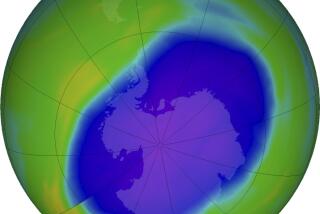Shuttle Atlantis Crew Retrieves Satellite Measuring Ozone Layer
- Share via
KENNEDY SPACE CENTER, Fla. — Racing high over the South Seas, the space shuttle Atlantis’ astronauts on Saturday captured a German satellite carrying vital measurements of Earth’s shrinking ozone layer.
Appropriately, the satellite was retrieved just north of Antarctica and its infamous ozone hole, south of New Zealand.
“Super! Super!” German scientists shouted in the satellite-control room at Kennedy Space Center as astronaut Ellen Ochoa grabbed the spacecraft with Atlantis’ robot arm. They celebrated with coffee and gummy bears.
“It’s not what you usually do when something important happens. You usually have a glass of champagne. We will do this on Monday,” when Atlantis returns to Earth with the satellite, German physicist Klaus Grossmann said.
The astronauts had released the $35-million satellite eight days earlier so it could observe ozone and other atmospheric gases without interference from Atlantis.
Shuttle commander Donald McMonagle flew over and around the 7,500-pound, triangular satellite, then hovered directly below at an altitude of 186 miles.
“It looks like a diamond in the sky,” he said.
McMonagle closed in on the satellite from below, testing a new approach to be used during Atlantis’ next flight--the first of seven to 10 dockings with Russia’s Mir space station.
Shuttles typically approach orbiting spacecraft from the front. By approaching from below, McMonagle used Earth’s gravity as a natural brake and thereby minimized the need for jet firings. NASA wants to avoid jet firings when Atlantis links with Mir in June to protect the station’s delicate solar panels from exhaust.
“That was a superb rendezvous,” Mission Control told the crew. “You’ve given us some important data and a lot of confidence. Well done.”
It was the high point for the six astronauts. They kept a rather low profile last week, watching over atmospheric monitors flying on the shuttle, testing experimental heat pipes and checking on 10 pregnant rats.
“It was very exciting, especially the view of the satellite,” Ochoa said before anchoring the satellite in the cargo bay.
Grossmann and other scientists are eager to get the satellite back. Hardly any measurements were beamed to the ground; virtually everything was stored on tapes on board.
Infrared telescopes on the satellite collected 15 million images of the atmosphere, measuring up to 14 atmospheric gases per second. Researchers want to know how these gases interact.
The thin, invisible layer of ozone in the stratosphere protects humans, animals and plants from dangerous ultraviolet radiation. It’s especially thin over the Antarctic, where a hole the size of North America forms every September because of man-made chemicals.
An ultraviolet instrument on the satellite measured gases responsible for ozone destruction. Six instruments aboard Atlantis also surveyed the ozone layer as well as solar energy; the seventh broke early in the 11-day mission.
More to Read
Sign up for Essential California
The most important California stories and recommendations in your inbox every morning.
You may occasionally receive promotional content from the Los Angeles Times.













